Auckland is nearing or passing through a peak, the rest of the upper North Island is within a week of a peak and other regions are following behind.
The Asian and Pacific Peoples communities may reach their peak before the Pākehā and Māori communities.
Given the vulnerability of Māori in the regions, Māori may be the last ethnicity to peak.
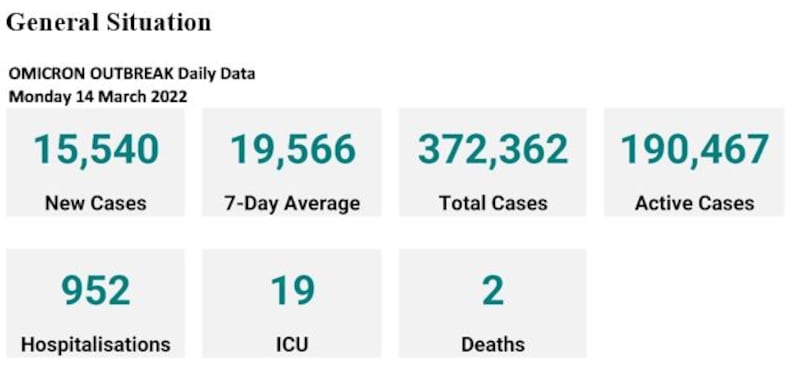
There have been 372,362 cases in the back-to-back Delta-Omicron outbreaks since August last year. Some 360,174 of those cases have been in the Omicron outbreak since February 1.
There were 15,540 new cases on Monday, the sixth consecutive day that cases have been lower than the high of 23,894 on March 8.
A slight uptick of cases on Monday, driven by new cases in the Pākehā and Māori communities, cautions that new cases could increase again.
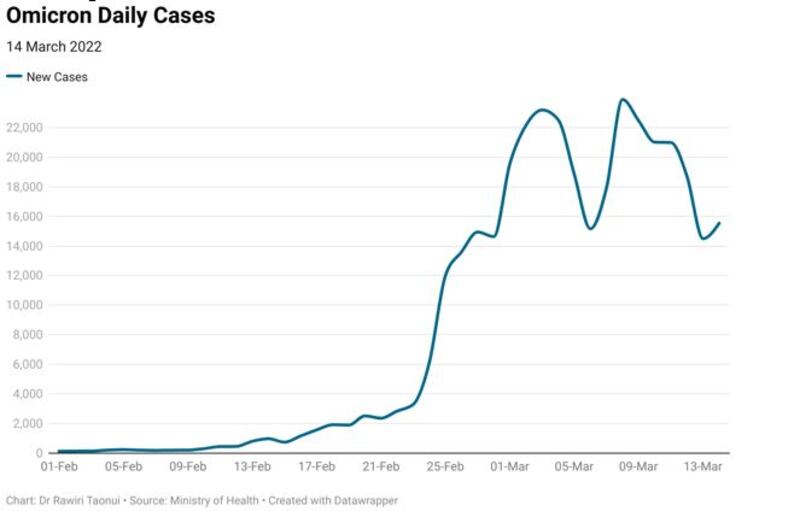
New Cases and Different Peaks by Ethnicity

The Pākehā community has had the highest number of cases for the last 10 days. Pākehā cases were steadily declining from a high of 10,650 on March 8 before rising again yesterday.
Māori have had the second-highest new cases for the last nine days. Cases were steadily dropping since a high of 5,332 on March 8 before rising again yesterday.
Last week, Māori cases were closing the gap to Pākehā cases. Cases appear to have widened again although Māori cases continue to rise as a proportion of all cases in non-Auckland District Health Boards (see below).
Analysts need to be careful about predicting a peak. With a slight uptick in new cases on Monday, Pākehā and Māori cases rose after a trough last week and may do so again. there are likely to bemore Māori cases in the regions.
A steady and significant decline in Pasifika and Asian cases, both of which have large communities in metro Auckland, suggest these communities may have reached their peak there and in other parts of the upper North Island.
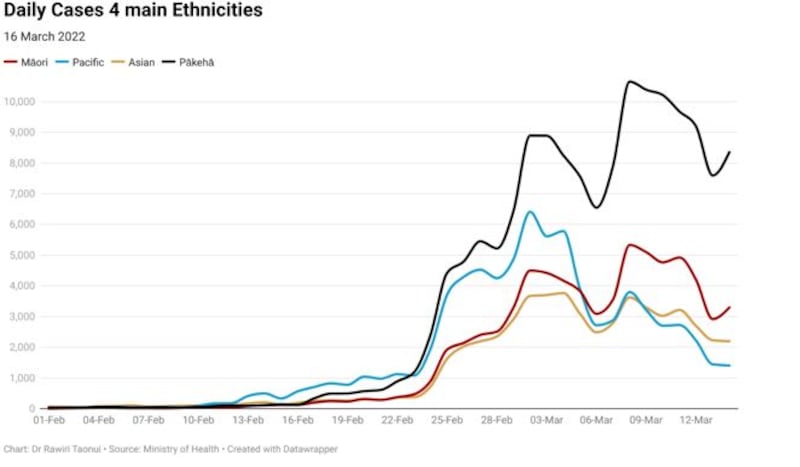
Active Cases by DHB
There were 190,467 active cases, the fourth consecutive day that cases have been lower than the high of 208,734 on March 10.
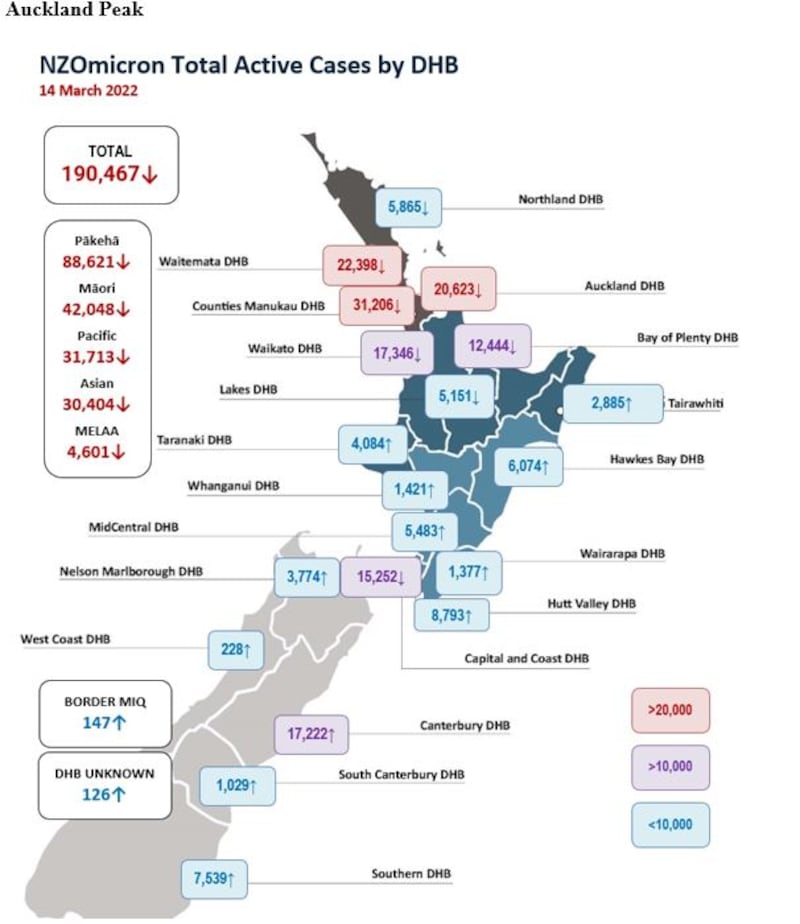
A three-day decrease in active cases in the three Auckland DHBs suggests the City of Sails is either near or at its peak. A significant decrease of active cases in the Pacific Peoples and Asian communities (see above) support this inference. Both communities have significant demographics in metro Auckland.
Corresponding decreases in Northland, the Waikato, the Bay of Plenty, and the Lakes on Monday suggest that other DHBs in the upper North Island are reaching a peak close behind Auckland.
All other DHBs in the central and lower North Island and the South Island continue to have rising active cases. The peak in these regions is running behind Auckland and the upper North Island.
The sidebar on the table below shows that all ethnicities have declining active cases. This reflects the greater decrease in cases in Auckland over-shadowing continuing rising cases in other parts of the country.
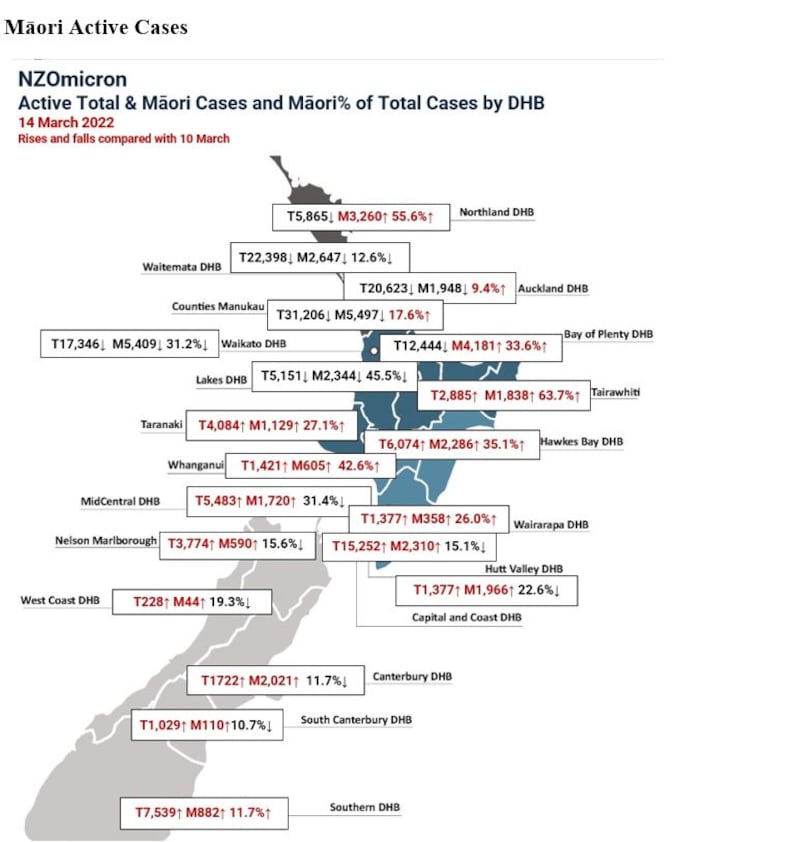
Early peak DHBs
Active cases are declining in DHBs heading to an early peak (Waitematā, Auckland, Manukau, Waikato, Lakes), but more slowly for Māori whose percentage of totals are increasing in Auckland and Manukau DHBs.
Māori cases are increasing more slowly than those for other ethnicities in the high Māori vaccinated MidCentral, Capital and Coast, Hutt, Nelson, Canterbury, West Coast, South Canterbury and Southern DHBs.
While total active cases are declining, Māori are an increasing percentage of active cases in the low Māori Vaccinated DHBs of Northland and the Bay of Plenty.
Total cases are increasing across the Central North Island with Māori cases increasing faster than other ethnicities in the lower Māori vaccinated DHBs of Te Tairāwhiti, Hawkes Bay, Wairārapa, Whanganui and Taranaki.
Infections and hospitalised cases
The table below shows the number of new Māori cases and hospitalisations since February 1 (an index this writer uses to differentiate between the overlapping Delta and Omicron outbreaks).
There have been 360,174 cases in the Omicron OutBreak since February 1 of whom 70,121 are Māori.
Māori have contributed a significantly higher percentage of unvaccinated 12yrs+ (32.7%) and unvaccinated under-12yrs cases (24.6%) to national totals than their 17.1% demographic share of the population.
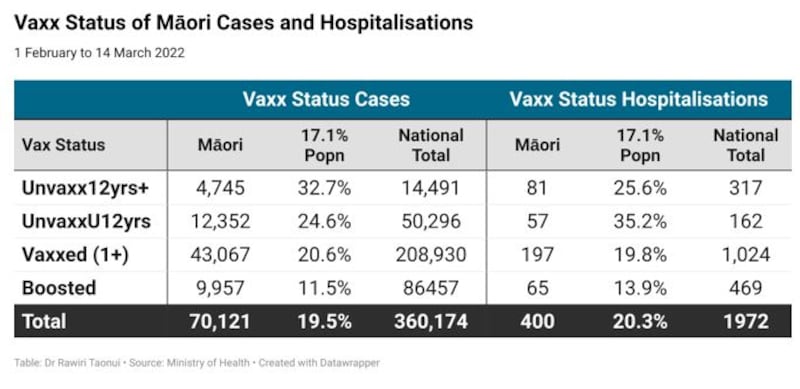
Comparing demographics, the 12yrs+ figure is second only to the Pākehā community (42.6%), which comes from a much larger 71.7% population base.
Pacific peoples (18.9%) contribute a higher 2.4 times demographic; Māori are 1.9 times demographic. The key point is that unvaccinated 12yrs+ Māori and Pacific Peoples are a disproportionate number of cases under Omicron. To reiterate this point, the Asian population, which has the highest vaccinated in Aotearoa, has contributed just 3.9% of all unvaccinated 12yrs+ cases.
By percentage and relative to demographic, Māori contribute the lowest percentage of boosted cases (11.5%) to the national total.
There have been 1,972 hospitalisations since February 1, of which 400 have been Māori.
By percentage, Māori contribute the second-highest proportion of unvaccinated 12yrs+ (25.6%) and under-12yrs (35.2%) hospitalisations after Pacific peoples (42.9% and 34.6%).
In contrast, by percentage and relative to demographic, Māori contribute the second-lowest number of boosted hospitalisations (13.9%) after the highly vaccinated Asian community (4.7%).
While the Māori community has much lower vaccinations than the Asian community, its double and boosted vaxxed community is hyper-vigilant on protecting whānau and whakapapa.
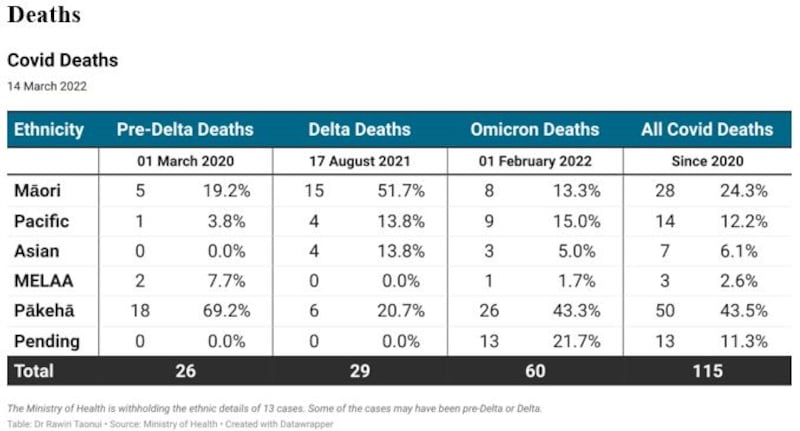
There have been a total of 115 deaths since Covid-19 arrived in Aotearoa. Some 26 occurred during pre-Delta outbreaks, 29 during Delta, and 60 since February 1 which marks the beginning of the Omicron outbreak.
Pākehā, particularly senior citizens, dominated deaths during earlier outbreaks. Māori dominated the Delta outbreak. Many of the current Omicron deaths are again from seniors in the Pākehā community.
It is difficult to fully assess the ethnic data because the Ministry of Health is withholding the ethnic details of 13 cases (pending). This writer has ascribed them to the Omicron outbreak until notifications suggest otherwise.
Kia noho haumaru, stay safe.
Dr Rawiri Taonui.



